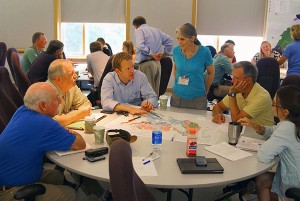About Us
Chesapeake Conservation Partnership is a coalition of diverse organizations and agencies engaged in land conservation and related fields within the Chesapeake Bay watershed. Partners seek to extend the conservation of large landscapes throughout the region to benefit multiple values, including economic sustainability; scenic, historic and cultural heritage; working lands; important wildlife habitat; water quality and supply; and overall quality of life.

The group bridges the connection between ecological, cultural and recreational resources. While conserving ecological resources is important, participants recognize that there are other reasons that compel individuals and organizations to conserve land or water, such as a cultural or recreational connection to the resources or because it is part of their heritage.
The Partnership provides a forum and an opportunity for organizations and agencies to improve conservation in the Chesapeake by influencing policy and funding at a higher level. We work across jurisdictional boundaries using an action-oriented and non-bureaucratic approach to get work done. Partners set goals and share information collaboratively through dedicated work groups.
The Chesapeake Conservation Partnership is jointly convened by the Chesapeake Conservancy, National Park Service Chesapeake Bay Office and US Fish & Wildlife Service.
The CCP Steering Committee members represent federal and state government senior managers and many nonprofit land trusts and other nonprofits in the conservation/environmental fields. As outlined by charter, the Committee’s major responsibility is to provide leadership in the development and implementation of the Partnership’s annual goals, priorities and strategies. The CCP stands up Protected Lands Workgroup to set, implement, and track commitments. CCP also works closely with the Chesapeake WILD initiative to help coordinate action towards habitat conservation. CCP helps coordinate the WILD Roundtable which aids in providing direction and support for the WILD grants system as well as providing strategic direction in habitat conservation throughout the watershed under the 5 pillars of WILD.
